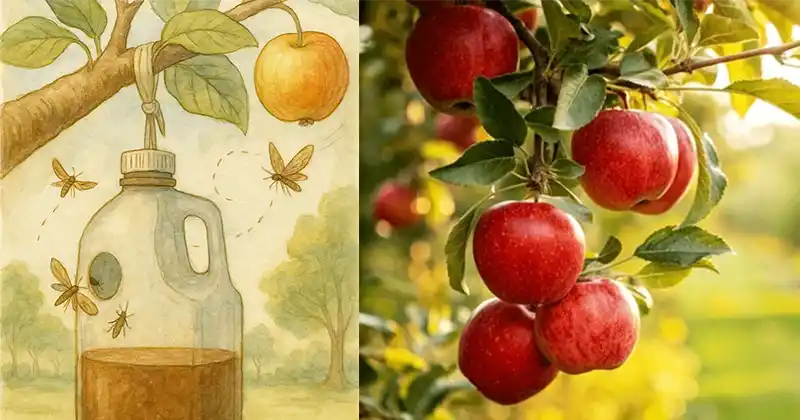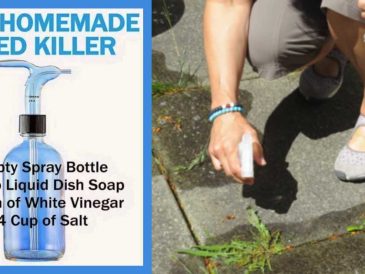Keeping apples free of “worms” (the larvae of the codling moth) is one of the biggest challenges for backyard growers who prefer natural methods. Fortunately, you don’t need harsh chemicals or expensive commercial sprays to protect your fruit. A simple homemade codling moth trap, made from a used milk jug and a sweet fermented bait, can dramatically reduce moth activity and help you grow clean, healthy apples all season long.

This method has been used for generations, and it remains one of the most effective organic helpers—especially when combined with a few orchard habits that break the moth life cycle naturally.
What You Need to Make the Trap
- 1 clean 1-gallon plastic milk jug (with the cap)
- Sharp knife or hole saw
- String, twine, or cloth strip for hanging
- Optional: funnel to pour the bait
- Bait ingredients (makes ~1.5 quarts):
- 1 cup apple cider vinegar
- 1/3 cup dark molasses
- 1/2 teaspoon household ammonia
- Water to reach 1.5 quarts total
Best Time to Hang the Trap
Right after the blossoms fall (petal fall) — this is when the first moths are searching for places to lay eggs.
Leave the traps out through the entire summer for continuous protection.
How to Make the Trap (Step-By-Step)
1. Cut the Entry Hole
Using a sharp knife, cut a round opening about the size of a small egg just below the jug’s shoulder (on the side opposite the handle).
This size is big enough for moths to enter but small enough to avoid rain splash.
2. Mix the Bait
Pour the vinegar, molasses, and ammonia into the jug.
Add water until you reach roughly 1.5 quarts.
Swirl gently to mix everything together.
The unique combination of sweet, fermented, and slightly sharp scents attracts adult codling moths extremely well.
3. Fill and Cap the Jug
Pour the mixture into the jug (a funnel simply keeps things tidy).
Put the cap back on — this forces the scent to vent slowly from the entry hole and keeps rainwater out.
4. Hang the Trap in the Tree
Use a cloth strip, string, or twine to tie the jug to a sturdy branch.
Ensure the entry hole faces slightly downward so rain doesn’t run in.
Ideal height: 5–6 feet (1.5–2 meters).
Choose a spot with good airflow and some sun exposure, usually the south or west side of the tree.
5. How Many Traps Per Tree?
- Mature trees: 2–4 traps
- Small or young trees: 1–2 traps
Spacing them around the tree increases the trap’s reach and keeps moth numbers low throughout the canopy.
Maintenance: Keep It Working All Season
Check the trap every 2–4 weeks.
In hot weather, bait evaporates faster, so weekly checks help keep the trap effective.
When the jug fills with bugs or the scent weakens:
- Empty the “bug soup”
- Add fresh bait
- Rehang the trap
Consistent refreshing keeps moth populations down from early spring until harvest.
Why This Trap Works
Codling moths are strongly attracted to fermenting sweetness, especially when combined with a hint of ammonia (which mimics natural nitrogen sources).
Once they enter the jug, they become trapped, fall into the liquid, and drown.
Every moth caught = fewer eggs laid = fewer larvae boring into your apples.
The results aren’t instant, but over one season you’ll notice a big reduction in damage, and over multiple seasons, the improvement gets even better.
Boost Your Results: Add These Natural Habits
1. Pick Up Fallen Apples Weekly
Larvae often finish developing inside dropped apples.
Removing this fruit interrupts the life cycle and prevents new moth generations.
2. Bag Your Apples
About 2–3 weeks after bloom, slip paper bags or mesh bags over young fruits.
This prevents the moths from laying eggs directly on the apples.
It’s extremely effective for small backyard orchards.
3. Light Pruning for Better Airflow
Open, airy trees reduce pest pressure and create a healthier growing environment overall.
4. Optional: Monitor with Sticky Pheromone Traps
These do not replace the jug trap but help you see when moth flights begin and peak.
Great for timing bagging or adding extra traps.
The Result: Cleaner Apples, Zero Chemicals
With just a reused milk jug, a few pantry ingredients, and basic upkeep, you can dramatically reduce codling moth damage.
This DIY trap is inexpensive, safe for kids and pets, and gentle on beneficial insects when hung correctly.
Combine it with good orchard habits and you’ll enjoy beautiful, worm-free apples without resorting to synthetic sprays.
Inspired by this? Share the article with your friends!





